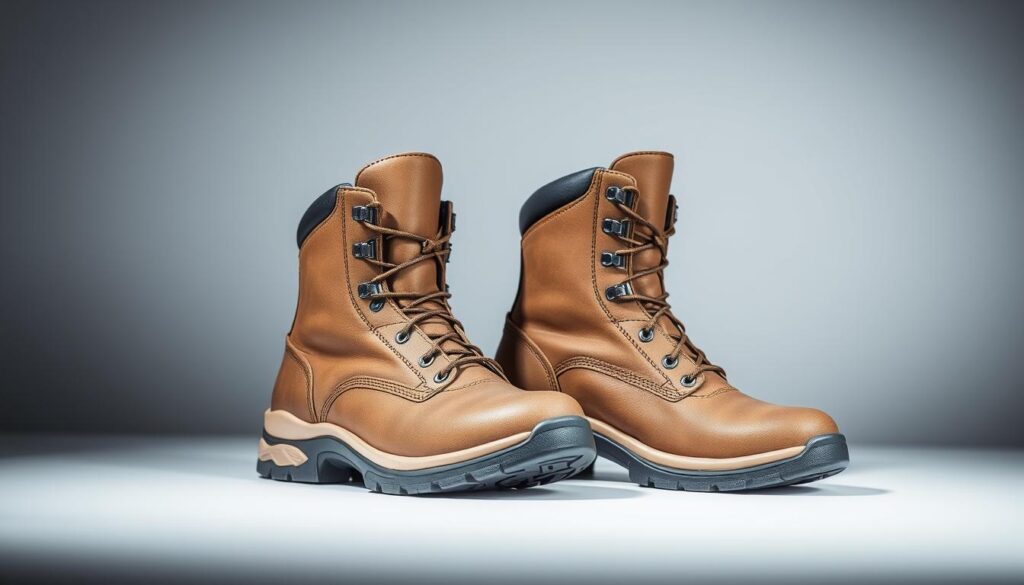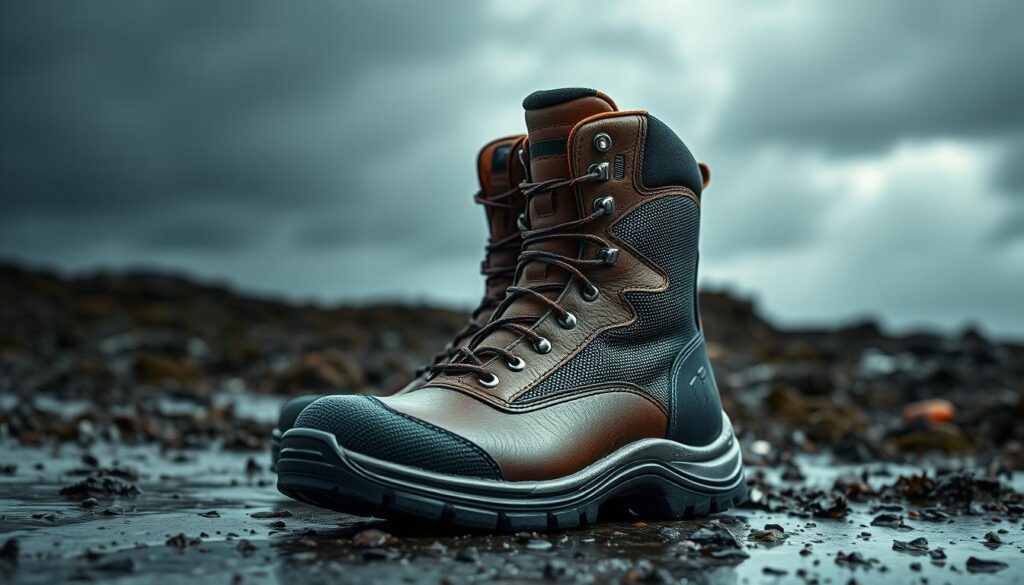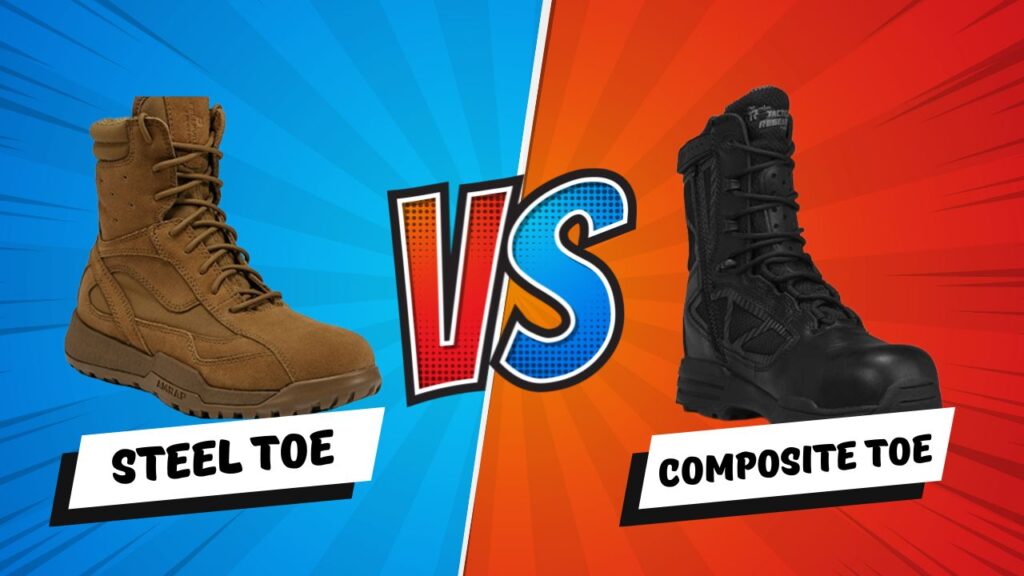Did you know that foot injuries account for nearly 15% of all workplace accidents in the United States? In hazardous environments, the right safety footwear can make all the difference. Whether you’re working in construction, warehousing, or any other high-risk industry, choosing between steel toe and composite toe boots is a critical decision.
Both options meet ASTM safety standards, ensuring your foot is protected from falling objects and compression. However, they differ in weight, conductivity, and comfort. Steel toe boots are known for their durability and higher impact protection, while composite toe boots are lighter and non-conductive, making them ideal for electrical hazards.
As we dive deeper, we’ll explore the key factors that influence your choice, from performance to environmental suitability. Our analysis is based on data from leading experts, ensuring you make an informed decision for your work environment.
Key Takeaways
- Foot injuries are a significant risk in many workplaces, making safety footwear essential.
- Both steel toe and composite toe boots meet ASTM safety standards.
- Steel toe boots offer higher impact protection but are heavier.
- Composite toe boots are lighter and non-conductive, ideal for electrical hazards.
- Your choice depends on factors like weight, comfort, and environmental needs.
Introduction to Safety-Toe Boot Options
Safety-toe boots are a must-have for anyone working in hazardous environments. These boots are designed to protect your foot from falling objects, heavy machinery, and other workplace dangers. Whether you’re in construction, manufacturing, or electrical work, the right safety footwear can prevent serious injuries.
Traditional steel toe boots have been the go-to choice for decades. They offer excellent impact protection and durability. However, advancements in materials have led to the rise of composite toe options. These boots use lightweight materials like carbon fiber, Kevlar, or plastic, making them ideal for specific job requirements.
The Role of Safety-Toe Boots in Work Environments
In industries with high risks, such as construction or warehousing, safety is paramount. Boots with protective caps ensure your foot is shielded from compression and impact. OSHA and ASTM standards require these boots to meet specific safety criteria, ensuring they provide reliable protection.
Overview of Steel Toe and Composite Toe Materials
Steel toe boots are made from heavy-duty metal, offering unmatched strength. They are perfect for environments with heavy machinery or tools. On the other hand, composite toe boots are lighter and non-conductive, making them safer for electrical work. Both options meet ASTM standards, but their material differences cater to unique workplace needs.
As we explore further, we’ll dive into the technical aspects of these materials and how they impact performance. This will help you make an informed decision based on your specific work environment.
Protection and Performance Standards
When it comes to workplace safety, the standards for protective footwear are non-negotiable. Whether you’re in construction, manufacturing, or electrical work, your safety depends on boots that meet rigorous testing criteria. The ASTM F2412 and F2413 standards ensure that all safety footwear provides reliable protection against impact and compression hazards.
ASTM Testing and Certification Requirements
All safety footwear must pass the same impact and compression tests under ASTM guidelines. These tests simulate real-world hazards, ensuring the foot is shielded from falling objects or heavy machinery. Both steel toe and composite toe boots are held to these standards, guaranteeing a minimum level of protection regardless of the material used.
Certification codes are another critical aspect. These codes indicate which hazards a boot is tested against, such as puncture resistance (PR) or electrical hazard resistance (EH). For example, a boot with an EH rating is non-conductive, making it safer for electrical work. Understanding these codes helps you choose the right footwear for your specific job requirements.
Understanding Impact and Compression Ratings
Impact and compression ratings are essential for evaluating a boot’s safety performance. The ASTM F2412 standard measures a boot’s ability to withstand a 75-pound object dropped from 18 inches. Compression tests assess how much weight the boot can handle without crushing the foot. Both tests ensure that the footwear provides adequate protection in high-risk environments.
“ASTM-compliant footwear is designed to meet the highest safety standards, ensuring workers are protected from common workplace hazards.”
Here’s a quick breakdown of key ASTM standards:
| Standard | Test | Purpose |
|---|---|---|
| ASTM F2412 | Impact Resistance | Protects against falling objects |
| ASTM F2413 | Compression Resistance | Shields from heavy machinery |
| EH Rating | Electrical Hazard Resistance | Prevents electrical shocks |
By understanding these standards, you can make an informed decision about the right safety footwear for your needs. Whether you choose steel toe or composite toe boots, both options are designed to keep you safe on the job.
Comfort: Weight, Fit, and Ergonomics
Comfort is a critical factor when choosing the right safety footwear for long workdays. The weight and fit of your boots can significantly impact your energy levels and overall performance. Let’s explore how these factors contribute to comfort and productivity.
Assessing Boot Weight and Long-Day Fatigue
The weight of the toe cap, though a small part of the boot, can influence fatigue over time. Steel toe options are durable but heavier, which may lead to tiredness during extended wear. In contrast, composite toe boots are lighter, making them a better choice for reducing strain.

Studies show that lighter footwear can improve mobility and reduce fatigue. For example, workers wearing lighter boots reported less discomfort after long shifts. This makes composite options ideal for jobs requiring constant movement.
Tips for Ensuring a Perfect Fit
A well-fitting boot minimizes risks like blisters and discomfort. Here are some practical tips to achieve the right fit:
- Try boots in the late afternoon when your feet are slightly swollen, ensuring a snug fit throughout the day.
- Choose socks that match your work environment, such as moisture-wicking options for hot conditions.
- Consider replacing stock insoles with aftermarket ones for better arch support and cushioning.
“A proper fit is essential for both comfort and safety, ensuring your boots protect you without causing pain.”
By prioritizing weight and fit, you can enhance your comfort and productivity. Whether you choose steel toe or composite toe boots, the right fit ensures you stay safe and focused on the job.
Weather and Environmental Considerations
Extreme weather conditions can significantly impact your choice of safety footwear. Whether you’re working in freezing cold storage or scorching outdoor environments, the right boots ensure both protection and comfort. Let’s explore how different materials perform in these conditions.

Performance in Cold and Hot Weather Conditions
Steel toe boots, made from metal, conduct heat and cold efficiently. This can make your feet feel colder in winter or hotter in summer. In contrast, composite toe boots are made from materials like carbon fiber or Kevlar, which are poor thermal conductors. This makes them more comfortable in extreme temperatures.
For example, workers in cold storage facilities often prefer composite options to avoid the chill of metal. Similarly, those in hot outdoor environments benefit from the insulation properties of composite materials.
Insulation and Waterproof Features
Insulation and waterproofing are critical for maintaining comfort in adverse conditions. Many steel toe boots come with added insulation to counteract the cold conductivity of metal. Waterproof features, such as sealed seams and moisture-wicking liners, keep your feet dry in wet environments.
Composite options often include advanced materials that optimize both warmth and protection. For instance, some boots use breathable membranes to regulate temperature while keeping water out. These features make them ideal for jobs requiring long hours in challenging weather.
“Choosing the right boots for your environment ensures you stay safe and comfortable, no matter the weather.”
Here’s a quick comparison of key features:
- Steel toe: Durable but conducts heat and cold, requiring added insulation.
- Composite toe: Lightweight and thermally insulating, ideal for extreme weather.
- Both options can include waterproofing and advanced materials for enhanced comfort.
By considering these factors, you can make an informed choice that meets your specific work environment needs. Whether you prioritize warmth, dryness, or overall comfort, the right boots make all the difference.
Steel Toe vs. Composite Toe Tactical Boots: Detailed Comparison
Choosing the right safety footwear involves understanding the unique properties of each option. Both steel toe and composite toe boots offer distinct advantages, depending on your work environment and specific needs. Let’s break down the key differences to help you make an informed decision.
Material Properties and Conductivity
The materials used in these boots play a significant role in their performance. Steel toe options are made from heavy-duty metal, providing unmatched durability and impact resistance. However, this material conducts heat and electricity, which can be a drawback in certain environments.
On the other hand, composite toe boots are crafted from lightweight materials like carbon fiber or Kevlar. These materials are non-conductive, making them safer for electrical work. They also offer better insulation, keeping your feet comfortable in extreme temperatures.
Job-Specific Benefits and Drawbacks
Different jobs require different levels of protection and comfort. For example, construction workers often prefer steel toe boots for their superior impact resistance. These boots are ideal for environments with heavy machinery or falling objects.
In contrast, workers in electrical or airport settings benefit from composite toe boots. Their non-conductive properties make them safer around electricity, and they won’t set off metal detectors. Additionally, their lighter weight reduces fatigue during long shifts.
“The right choice depends on your specific work environment and the hazards you face daily.”
Here’s a quick comparison of the two options:
| Feature | Steel Toe | Composite Toe |
|---|---|---|
| Material | Metal | Carbon Fiber/Kevlar |
| Weight | Heavier | Lighter |
| Conductivity | Conductive | Non-Conductive |
| Best For | Construction, Heavy Machinery | Electrical Work, Airports |
By understanding these differences, you can choose the safety footwear that best suits your needs. Whether you prioritize durability, weight, or conductivity, both options offer reliable protection in high-risk environments.
Special Considerations for Metal Detectors and Job Safety
Navigating workplace security checkpoints can be a challenge for workers wearing traditional safety footwear. Metal detectors, commonly found in airports, secure facilities, and certain job sites, often pose issues for those with steel toe boots. This section explores how composite toe options can address these challenges while maintaining job safety.
Navigating Metal Detector Restrictions
Metal detectors are designed to identify metallic objects, which can include the caps in steel toe boots. This can lead to delays or additional screening for workers. In contrast, composite toe boots are made from non-metallic materials like carbon fiber or Kevlar, making them ideal for environments with strict security protocols.
For example, workers in airports or secure facilities benefit from composite toe boots, as they won’t set off metal detectors. This not only saves time but also reduces the risk of disruptions in high-security areas.
Design Considerations for Non-Metallic Boots
When choosing composite toe boots, it’s important to ensure they are entirely non-metallic. Some boots may include a steel shank for added support, which can still trigger metal detectors. Always check the product specifications to confirm the absence of metallic components.
“A completely non-metallic boot ensures seamless passage through security checkpoints while maintaining workplace safety.”
Here’s a quick comparison of key features for boots in metal detector environments:
| Feature | Steel Toe | Composite Toe |
|---|---|---|
| Material | Metal | Carbon Fiber/Kevlar |
| Metal Detector Compatibility | Triggers Detectors | Does Not Trigger Detectors |
| Best For | High-Impact Work | High-Security Areas |
By understanding these differences, workers can choose the right safety footwear that balances job protection with practical restrictions. Whether you’re in a high-security facility or a job site with frequent metal detector checks, the right boots make all the difference.
Conclusion
Making the right choice in safety footwear ensures both protection and comfort on the job. Whether you prioritize the durability of steel toe options or the lightweight, non-conductive benefits of composite toe boots, both meet essential ASTM standards for workplace safety.
Your decision should align with your specific work environment. For heavy-duty tasks, steel toe boots offer unmatched impact resistance. In contrast, composite toe boots excel in electrical work and extreme weather conditions due to their insulating properties.
Always consider factors like weight, comfort, and job requirements. By doing so, you can ensure your footwear provides the necessary protection while keeping you comfortable throughout the day. Take the time to evaluate your needs and make an informed choice for your safety and productivity.

